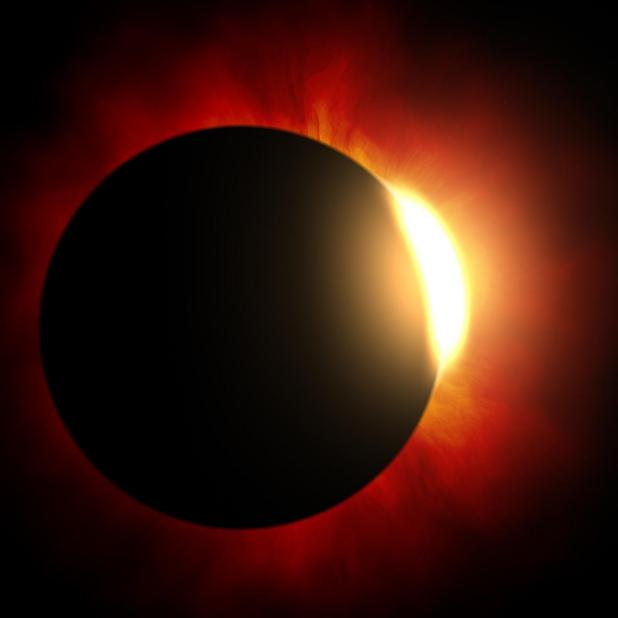
THERE GOES THE SUN
The sun is almost covered by the moon in this file photo of a previous solar eclipse. While some areas of the nation will experience a total eclipse on Aug. 21, the moon will only cover about 80 percent of the sun in Avoyelles Parish.
‘American’ eclipse will occur Monday
If you look into the sky on Aug. 21 and it looks like some evil monster is eating the sun, don’t be alarmed -- except that you shouldn’t be looking at the sun during an eclipse.
The Great American Eclipse will provide a total eclipse of the sun for those Americans living in a 70-mile-wide west-to-east band stretching across 14 states from Oregon to South Carolina. The band will include Oregon, Idaho, Wyoming, Montana, Nebraska, Iowa, Kansas, Missouri, Illinois, Kentucky, Tennessee, Georgia, North Carolina and South Carolina.
In Marksville, the eclipse will be about 80 percent. It will begin at about 11:50 a.m., reach its maximum coverage just after 1:20 p.m. and be finished by 2:50 p.m.
There has been no announced special eclipse-related event in the parish, but science teachers are expected to use the occasion as a learning opportunity for their students.
“I know I always taught a special lesson whenever there was a solar or lunar eclipse,” recently retired high school science teacher Terry Laborde of Hessmer said.
Solar eclipses in this area are rare, he noted, so he would conduct a class on the event whenever there was an eclipse anywhere.
“Lunar eclipses are more common,” he added.
On Aug. 21, the moon will be passing between earth and the sun, creating what many consider to be one of nature’s most awe-inspiring events -- a solar eclipse. All or part of the sun will be blocked for about three hours.
The eclipse will enter America in Oregon shortly after 9 a.m. Pacific Time and leave the United States at just after 4 p.m. Eastern Time.
Those in that path will have a total eclipse of varying lengths. Carbondale, Ill., will have the longest total eclipse with the sun being hidden for about 2 minutes and 40 seconds.
While there have been partial eclipses in the United States over the years, its last total eclipse was in 1979.
“I remember the last partial eclipse we had here -- in May 1982,” Laborde said. “I remember that because I had just started teaching at Marksville High.”
SAFE VIEWING
Laborde said the most important thing to know about solar eclipses is not to look at it with the unprotected eye -- and to know what does and does not constitute adequate protection.
NASA says it is only safe to look at the sun during the brief period of “totality.” And it is important in that case to be ready to don protective filtered eyeglasses or look away before that period of totality ends.
That means skywatchers in this area must find alternative ways to witness the event.
Looking at the sun without appropriate protection can severely damage the retinas of the eyes. However, there are ways to safely view the eclipse, Laborde said.
This includes direct viewing with a filtering device or an indirect viewing method where an image of the sun is projected onto a screen and the process of eclipse plays out for the viewer. Both methods provide clear images of the phases of eclipse.
Regular sunglasses are not an appropriate filtering device.
If you cannot find or do not want to purchase an inexpensive pair of “eclipse glasses” that meet federal standards, experts say a widely available filter for safe viewing is No. 14 welder’s glass.
“It is imperative that the welding hood houses a #14 or darker filter,” NASA’s eclipse safety website states. “Do not view through any welding glass if you do not know or cannot discern its shade number.”
The site notes that most arc welders use a shade much less than No. 14.
“A welding glass that permits you to see the landscape is not safe,” NASA notes.
Laborde said he has heard many people say they will look at the eclipse through their welding helmet, not realizing the helmet may not be dark enough to provide the necessary protection to avoid damaging their retinas.
The best view would be through a telescope with a solar filter or a solar telescope, which would allow seeing more detail.
Never look at the eclipse through an unfiltered telescope or binoculars. Laborde said that might actually concentrate the damaging rays from the sun.
A popular method is the “pinhole projector” method of viewing an eclipse.
One way to create this is to “cross the outstretched, slightly open fingers of one hand over the outstretched, slightly open fingers of the other, creating a waffle pattern,” NASA explains. “With your back to the sun, look at your hands’ shadow on the ground. The little spaces between your fingers will project a grid of small images on the ground, showing the sun as a crescent during the partial phases of the eclipse.” For more information and safe viewing tips, visit https://eclipse2017.nasa.gov/ safety.
NEXT ECLIPSE
While the nation had to wait 38 years for another total eclipse, it will have another opportunity in just seven.
The eclipse of April 8, 2024 will be even closer to totality here than this one, with the total eclipse band cutting a southwest to northeast path, entering the U.S. from Mexico and then sweeping across Texas, Oklahoma, Arkansas, Missouri, Indiana, Ohio, New York, Vermont and Maine before entering Canada.
The total eclipse will last between 3 min. 30 sec. and 4 min. 30 sec. -- one to two minutes longer than this August’s longest period.
The 2017 eclipse band’s closest point to Avoyelles is in Missouri while the 2024 eclipse band’s closest point to us will be in southern Arkansas.
